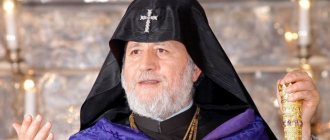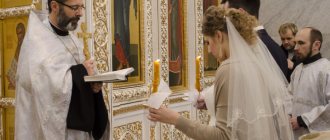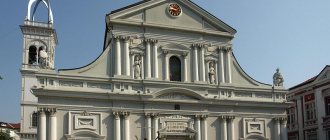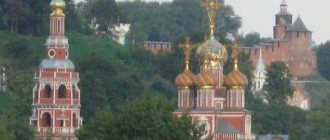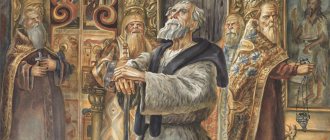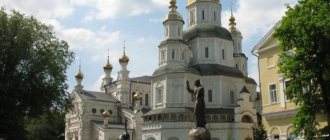The Ecumenical Patriarch is the primate of the Church of Constantinople. Historically, he is considered the first of equals among the primates of all local churches. We’ll talk about what this means and how this story came about a little later. Now we will find out who the Ecumenical Patriarch is. So, on October 22, 1991, Bartholomew I (in the world Dimitrios Archodonis), also known as His Divine All-Holiness, Archbishop of Constantinople (the old name of the city of New Rome), was awarded this title.
Patriarch
This title was formed when the city of Constantinople became the capital of the Byzantine Empire. The first Ecumenical Patriarch Akakios (472-489) was titled after the Fourth Ecumenical Council (451, Chalcedon). Then, in rules 9, 17 and 28, the imperial jurisdiction of the Bishop of New Rome was proclaimed, occupying second position in importance after that of Rome.
By the end of the 6th century, the role and title were finally accepted in both civil and ecclesiastical acts of the Byzantine Empire. But the papal throne of Rome did not accept the 28th rule. It was only in connection with the union at the VII Ecumenical Council (1438-1445) that Rome finally placed the Patriarchate of Constantinople in a second role.
Empire as a Universe
First of all, it is necessary to understand the word “universe” itself - in Greek οἰκουμένη. This is a passive participle from the verb οἰκέω “to live, inhabit, inhabit” with the usually omitted noun “earth”, that is, literally “earthly space inhabited by man.” This is what the ancient Greeks called the world they knew, in contrast to distant regions that were either uninhabited or inhabited by wild barbarians. Usually, the “universe” was not understood as the whole world, but only that part of it where civilization existed. The rulers of large kingdoms were called “kings of the universe,” such as Cyrus of Persia in the Bible (2 Esdras 2:2). And when the Greco-Roman civilization was united under the rule of the Roman emperors, the “universe” began to be called the Roman Empire. It is in this sense that St. uses this word. Apostle Luke, when he talks about the Nativity of Christ: “Now it came to pass in the days of thee, and when Caesar Augustus commanded that the whole universe should be written” (πᾶσαν τὴν οἰκουμένη ν - Luke 2:1). The term “ecumene” meant not so much an inhabited, but rather a cultivated space of ancient civilization. Other cultures had their own “universes” - and this understanding persisted for centuries. For example, when in 1262 the Bulgarian ruler Jacob Svyatoslav sent a list of the Helmsman’s Book to Metropolitan of All Rus' Kirill II, he wrote: “May the Russian universe be enlightened by your word” - “May the Russian universe be enlightened by your word!”
When the holy Equal-to-the-Apostles Emperor Constantine the Great convened bishops from all over his Empire in Nicaea in 325 to discuss general church problems, this meeting was called the “Ecumenical Council.” Thus was born an institution at the all-imperial level, at which, at the call of the emperors, on especially important occasions, bishops from all over the vast Roman state gathered - under the chairmanship of the most authoritative bishops, who over time began to be called “chiefs of the fathers” - Patriarchs.
The epithet “ecumenical” in the sense of “empire-wide, state-wide” became especially widespread in the legislation of Justinian the Great (527-565). In its laws the words “universe, universal” are constantly found as an indication of the entire territory of the Empire. And in the 109th novella of 541, the emperor gives a comprehensive explanation of the highest church institutions - Ecumenical Councils and Patriarchates: “The fathers also called heretics, and we call those who belong to various heresies ... and in general all who are not members of the Holy Catholic Church of God and the Apostolic Church, in which all the most holy Patriarchs of the entire Universe - and Western Rome, and this royal city, and Alexandria, and Teupol (Antioch - P.K.), and Jerusalem, and all the most reverend bishops subordinate to them - unanimously proclaim the Apostolic Faith and legend"[3].
So, from the point of view of imperial legislation, the Orthodox faith is proclaimed in agreement by the five “Patriarchs of the Universe” and the bishops subordinate to them - and it is to testify to this agreement that the Ecumenical Councils are assembled by the emperors. The order of veneration of the Patriarchs is determined by the canons (2 Ecum. 3; 4 Ecum. 28; Trul. 36) and enshrined in the laws of the Roman Empire (Codex Iustiniani, I.1.7, I.2.16; Novella Iustiniani 131, etc.): Rome - Constantinople - Alexandria - Antioch - Jerusalem. It is important to note that this list of the five patriarchal thrones by no means exhausts the number of autocephalous Local Churches: outside its framework are not only the Orthodox Churches that were located outside the Empire at that time (Georgian, Aquileian), but also independent Churches within its borders (Cyprus, Carthaginian , Justinian the First). The Pentarchy, according to Justinian, symbolized the unity of the Orthodox Church, the guarantors of which were the primates of the most authoritative episcopal thrones of the Empire.
And, most importantly, all five Patriarchs were considered “Ecumenical”.
Patriarchate in Rus'
But in 1453, Byzantium fell after the siege of Constantinople by Turkish troops. At the same time, the Ecumenical Patriarch of Constantinople was able to maintain his position as the leader of the Christian world, but already existed under the Ottoman Empire. Nominally he remained the head of the Russian Orthodox Church, but was very weakened and depleted materially until the patriarchate was established in the Russian state (1589). During the reign of Boris Godunov, as is known, Job became the first patriarch in Rus' (1589).
After the First World War, the Ottoman Empire ceased to exist. In 1923, Constantinople ceased to be the capital, in 1930 it was renamed the city of Istanbul.
Patriarchs of Constantinople (from 451)
451–998
- 46. Gennady I (458–471)
- 47. Akaki (471–488)
- 48. Fravitta (488–489), also Flavian II
- 49. Euphemius (489–495)
- 50. Saint Macedonius II (495–511)
- 51. Timothy I (511–518)
- 52. John II of Cappadocia (518–520)
- 53. Epiphanius (520–535)
- 54.Anthimus I (535–536)
- 55. Menas (536–552)
- 56. Eutyches (552–565)
- 57. John III Scholasticus (565–577) Eutyches (577–582), restored.
- Pyrrhus I (653–654), restored
This page of the icon painter Khludov Psalter
illustrates the line “They gave me gall to eat; and when I was thirsty, they gave me vinegar to drink,” with a picture of a soldier offering vinegar to Christ on a sponge attached to a post. John VII Grammaticus depicts Christ erasing a painting with the same sponge attached to a pillar. John is caricatured, here as on other pages, with unkempt, straight hair sticking out in all directions, which the Byzantines considered funny.
- 83. John VII Grammaticus (836–843)
- 84. Methodius I (843–847)
- 85. Ignatius I (847–858)
- 86. Saint Photius I the Great (858–867) Ignatius I (867–877), restored
- Saint Photius I the Great (877–886), restored
- Nicholas I Mystic (912–925), restored
999–1453
- 99. Sergius II (1001–1019)
- 100. Eustathius (1019–1025)
- 101. Alexius I the Studite (1025–1043)
- 102. Michael I Cerularius (1043–1058)
- 103. Constantine III Leichudes (1058–1063)
- 104. John VIII Xyphilinus (1063–1075)
- 105. Kosmas I (1075–1081)
- 106. Eustratius Garidas (1081–1084)
- 107. Nicholas III the Grammar (1084–1111)
- 108. John IX Agapetus (1111–1134)
- 109. Leo Stippeyot (1134–1143)
- 110. Michael II Kurkuas (1143–1146)
- 111. Cosmas II Atticus (1146–1147)
- 112. Nicholas IV Muzalon (1147–1151)
- 113. Theodotus II (1151–1153)
- 114. Neophytos I (1153–1154)
- 115. Constantine IV Chliaren (1154–1156)
- 116. Luke Chrysoberges (1156–1169)
- 117. Michael III Anchiala (1169–1177)
- 118. Khariton (1177–1178)
- 119. Theodosius I Boradiot (1178–1183)
- 120. Basil II Kamateros (1183–1186)
- 121. Mount Nikita II (1186–1189)
- 122. Dositheus (1189) (9 days)[1]
- 123. Lion of the Virgin (1189) Dositheus (1189–1191), restored
- vacant
(1240–1244)
- Arseny Avtoreyan (1261–1265), restored
- Joseph I Galesiot (1282–1283), restored
- Athanasius I (1303–1310), restored
- Callistus I (1355–1363), restored
- Macarius (1390–1391), restored
May 29, 1453 Fall of Constantinople, marking the end of the Byzantine Empire. The Ecumenical Patriarchate became the subject of the Ottoman Empire.
1453–1466
- 159. Gennady II Scholarius (1454–1456)
- 160. Isidore II Xanthopoulos (1456–1462)
Scholars have put forward various assumptions regarding the succession of the patriarchs from 1462 to 1466. The main positions are as follows:
According to Kiminas (2009):[2]
| According to Laurent (1968):[3]
| According to Gemanos of Sardeis (1933–38):[4]
|
1466–1833
- 165. Dionysius I (late 1466–1471) Simeon I of Trebizond (1471–1475), first restoration.
- Simeon I of Trebizond (1482–1486), restored for the second time.
- Dionysius I (1488–1490), restored
- Nephon II (1497–1498), first restoration.
- Nephon II (1502), restored 2nd time
- Joachim I (1504), restored
- Jeremiah I (1525–1546), restored
- Metrophanes III (1579–1580), restored
- Jeremiah II Thranos (1587–1595), restored a second time.
- Theophanes I Karikes ( locum tenens
, 1596)
, 1597)
, 1597–1598)
- Matthew II (1598–1602), first restoration.
- Matthew II (1603), restored 2nd time
- Neophytos II (1607–1612), restored
, 1612)
- Cyril I Lucaris (1620–1623), first restoration.
- Cyril I Lucaris (1623–1633), restored for the second time.
- Cyril I Lucaris (1633–1634), restored for the third time.
- Cyril I Lucaris (1634–1635), restored for the 4th time.
- Cyril I Lucaris (1637–1638) restored for the fifth time.
- Parthenius II (1648–1651), restored
- Athanasius III (1652), restored
- Ioannikios II (1653–1654), restored for the second time.
- vacant
(1659–1662)
- Parthenius IV (1665–1667), first restoration.
- Parthenius IV (1671), restored 2nd time
- Parthenius IV (1675–1676) restored for the third time.
- Dionysius IV Muselim (Muslim) (1682–1684), restored for the second time.
- Callinicus II (1689–1693), first restoration.
- Cyprian (1713–1714), restored
- Callinicus III (1726)[5]
- Jeremiah III (1732–1733), restored
- Paisius II (1740–1743), restored once.
- Paisius II (1751–1752), restored for the second time.
- Samuel I Chatseres (1773–1774), restored
- Neophyte VII (1798–1801), restored
- Gregory V (1806–1808), first restoration.
- Gregory V (1818–1821), restored for the second time.
On July 23, 1833, the Church of Greece declared itself autocephalous. This was followed by the Romanian Orthodox Church in 1864, the Bulgarian Exarchate in 1872, and the Serbian Orthodox Church in 1879, thereby reducing the territorial extent of the Ecumenical Patriarchate jurisdiction of Russia.
1834–1923
- 243. Constantius II (1834–1835)
- 244. Gregory VI (1835–1840)
- 245.Anthimus IV (1840–1841)
- 246. Antimus V (1841–1842)
- 247. Herman IV (1842–1845)
- 248. Meletius III (1845)
- 249. Antimus VI (1845–1848) Antimus IV (1848–1852), restored
- Hermann IV (1852–1853), restored
- Antimus VI (1853–1855), first restoration.
- Gregory VI (1867–1871), restored.
- Joachim III (1901–1912), restored
- vacant
(1918–1921)
July 24, 1923 The Ottoman Empire is dissolved, replaced by the Turkish Republic.
1923–present
- 261. Gregory VII (1923–1924)
- 262. Constantine VI (1924–1925)
- 263. Vasily III (1925–1929)
- 264. Photius II (1929–1935)
- 265. Benjamin I (1936–1946)
- 266. Maximus V (1946–1948)
- 267. Athenagoras I (1948–1972)
- 268. Demetrios I (1972–1991)
- 269. Bartholomew I (1991–present)
Power struggle
At the beginning of 1920, the Patriarchate of Constantinople in its ruling circles began to formulate the concept that the entire Orthodox diaspora of churches should completely submit to the Patriarch of Constantinople. Since it is he, in the opinion of the meeting of the Greek elite of the so-called Phanariots, who now has the primacy of honor and power, and therefore can interfere in any internal affairs of other churches. This concept was immediately subjected to repeated criticism and was called “Eastern papism.” However, it was de facto approved by the practice of the church.
Ecumenical Patriarch Bartholomew I: biography
Bartholomew is of Greek ethnic origin, who was born on February 29, 1940 on the Turkish island of Gökçeada in the village of Zeytinlikey. After graduating from high school in Istanbul, he continued his studies at Chalcedon Theological School and was ordained a deacon in 1961. Then he served two years in the Turkish army.
From 1963 to 1968 he studied at the Pontifical Oriental Institute in Rome, then studied at the University of Switzerland and Munich. He then taught at the Pontifical Gregorian University, where he received his doctorate in theology.
In 1968, the ordination to the priesthood took place, in which Patriarch Athenagoras I participated. In 1972, already under Patriarch Demetrius, he was appointed to the position of manager of the Patriarchal Cabinet.
In 1973 he was consecrated Metropolitan Bishop of Philadelphia, and in 1990 he became Metropolitan of Chalcedon. From 1974 until his enthronement as patriarch, he was a member of the Synod and a number of synodal committees.
In October 1991, he was elected as the Ecumenical Patriarch of the Church of Constantinople. The enthronement took place on November 2 of the same year.
Bishops of Byzantium (up to 330)
- 1. Apostle Andrew (38), founder
- 2. Holy Apostle Stachys (38–54)
- 3. Saint Onesimus (54–68)
- 4. Polycarp I (69–89)
- 5. Plutarch (89–105)
- 6. Sedecion (105–114)
- 7. Diogenes (114–129)
- 8. Eleutherius (129–136)
- 9. Felix (136–141)
- 10. Polycarp II (141–144)
- 11. Athenodorus (144–148)
- 12. Euzois (148–154)
- 13. Lawrence (154–166)
- 14. Alypius (166–169)
- 15. Pertinax (169–187)
- 16. Olympian (187–198)
- 17. Mark I or Marcus I (198–211)
- 18. Philadelphus (211–217)
- 19. Cyriacus I (217–230)
- 20. Castinus (230–237)
- 21. Eugene I (237–242)
- 22. Titus (242–272)
- 23. Dometius (272–284)
- 24. Rufinus I (284–293)
- 25. Probus (293–306)
- 26. Saint Mitrophan (306–314)
- 27. Saint Alexander (314–337)
Bartholomew and the Russian Orthodox Church
After his enthronement, Ecumenical Patriarch Bartholomew I visited the Russian Patriarch in 1993. After the schism in Russia in 1922 (when Constantinople showed its sympathies to church criminals rather than to the canonical church), this meant a thaw in their relations. Moreover, a split occurred in the Russian Orthodox Church again, supported by the Ukrainian authorities, then the self-proclaimed Kiev Patriarchate appeared, headed by Filaret. But at this moment, Bartholomew I supported the canonical Metropolitan of Kyiv, His Beatitude Vladimir (Sabodan).
In 1996, an acute conflict arose with the Estonian Apostolic Orthodox Church. Moscow did not recognize the church structure of the Patriarchate of Constantinople in Estonia as canonical. The name of Bartholomew was even excluded from the diptychs of the Russian Orthodox Church for some time.
Archbishops of Constantinople (330–451)
- 28. Saint Paul I (“Confessor”) (337–339)
- 29. Eusebius of Nicomedia (339–341) Paul I (341–342), restored 1 time.
- Paul I (346–350), restored for the second time.
- Florentius (c. 363)
Meetings
In 2006, a conflict situation arose in the Sourozh diocese of the MP in the British Isles. As a result, Bishop Basil, its former manager, was accepted into the bosom of the Church of Constantinople, but just as soon left there due to his desire to marry.
In 2008, in honor of the 1020th anniversary of the baptism of Rus', President of Ukraine V. Yushchenko was waiting for approval from Patriarch Bartholomew to unite the Ukrainian churches into a single local one, but did not receive it.
In 2009, Moscow Patriarch Kirill officially visited the residence of the Patriarch of Constantinople. During the negotiations, many important issues were discussed, while Bartholomew promised not to interfere in the church situation that had arisen in Ukraine.
Then, in 2010, there was a return meeting in Moscow, where the topic of the Great Pan-Orthodox Council was discussed. Bartholomew also called on the doubting believers of Ukraine to return to the canonical church.
Patriarch Bartholomew's relationship with the Roman Catholic Church
In 2006, Bartholomew invited Pope Benedict XVI to visit him in Istanbul, and the meeting took place. In a conversation, the Ecumenical Orthodox Patriarch lamented that the two churches had not yet united.
In 2014, the meeting between the Patriarch and Pope Francis took place in Jerusalem. It was regarded as private, the conversations were mainly conducted in an ecumenistic direction, for which he is now very much criticized.
An amazing fact of this meeting was that Pope Francis, as a sign of humility, kissed the hand of the patriarch, who, in turn, politely and tolerantly responded with a cross-shaped kiss.
see also
- Ambrose
- Apostolic succession
- Athanasius of Alexandria
- Basil of Caesarea
- Constantinople
- Cyril of Jerusalem
- Eastern Orthodoxy
- Ecumenical Patriarch of Constantinople
- Eusebius of Caesarea
- Gregory of Nyssa
- Hilary Poitier
- Jerome
- John of Damascus
- Latin Patriarch of Constantinople
- List of Armenian patriarchs of Constantinople
- Nikephoros Callistos Xanthopoulos
- Patriarch
- Pope Gregory I
- Socrates Scholastic
- Sozomen
- Theodoret
- Vincent Lerinsky
